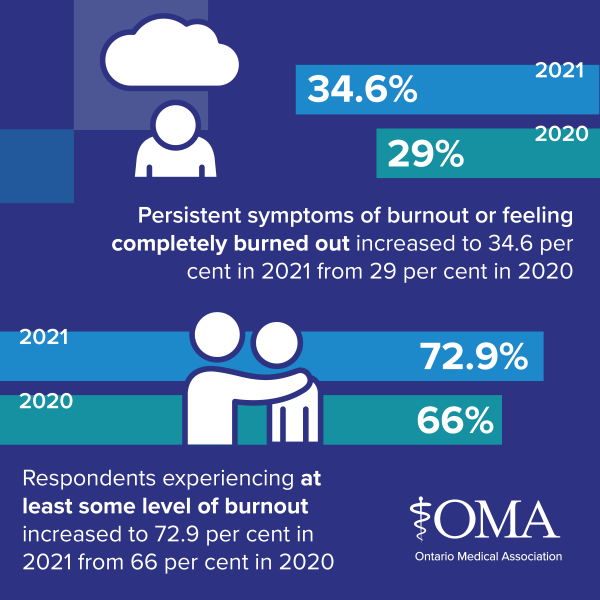TORONTO, Aug. 18, 2021—Almost three-quarters (72.9 per cent) of physicians surveyed by the Ontario Medical Association said they experienced some level of burnout in 2021, up from 66 per cent the previous year.
Just over one-third (34.6 per cent) reported either persistent symptoms of burnout or feeling completely burned out in 2021, up from 29 per cent in 2020.

A sweeping new report released by the OMA today found many causes of burnout. Topping the list were technology and the fact that many physicians spend more time completing required documentation than caring for patients.
“Burnout and its symptoms have impacted so many physicians, which unfortunately has been exacerbated by COVID-19,” said OMA President Dr. Adam Kassam. “Tackling this epidemic is one of the most urgent needs facing the profession. The system-level changes that are needed require bold action by our health-system partners. I am proud of the work done by the OMA and the Burnout Task Force, which continues to demonstrate leadership and provide solutions to support our colleagues.”
The OMA created a Burnout Task Force in 2019 to drive system-level changes and provide support to members. Even before the pandemic, nearly one-third of physicians in Canada were reporting high levels of burnout. Many other health-care workers are also experiencing burnout, especially nurses.
The pandemic has reinforced the need to find solutions, not just for the well-being of health-care workers but also to ensure there are sufficient health-care resources in place to address the deficit of care caused by the pandemic.
The OMA report includes five solutions to address burnout, starting with reducing and streamlining documentation. Studies have shown that physicians spend two hours on electronic documentation for every one hour of direct patient interaction. Primary care physicians spend about six hours a day recording patient information electronically, both during and after clinic hours.
The other top solutions are:
Physician burnout has been associated with increased depression, substance use and even suicidal thoughts. It could also reduce productivity, increase turnover and possibly decrease patient access to care.
Despite being burned out and at risk of contracting COVID-19 and transmitting it to their loved ones, Ontario’s doctors have provided the best possible care to their patients throughout the pandemic.
The OMA surveyed its members twice: once just as the COVID-19 pandemic was hitting North America in March 2020, and again in March 2021.
“Physician burnout is a system-level problem that has been worsened by the global pandemic,” said OMA CEO Allan O’Dette. “It needs to be addressed both for physician well-being and to ensure the health-care system can address the pandemic backlog of medical procedures. The OMA plan, in development since 2019, has actionable solutions to help solve this problem.”
It’s time to change Ontario’s health care for the better as the post-pandemic recovery begins. Complete our survey at betterhealthcare.ca and help shape the future of health care.
The Ontario Medical Association represents Ontario’s 43,000 plus physicians, medical students and retired physicians, advocating for and supporting doctors while strengthening the leadership role of doctors in caring for patients. Our vision is to be the trusted voice in transforming Ontario’s health-care system.
For further information: OMA Media Relations at media@oma.org.